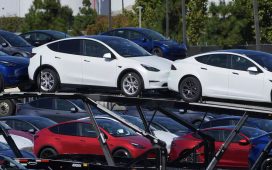Maskot | Maskot | Getty Images
After a year of supply shortages and climbing borrowing costs, 2024 is shaping up to be a better time to buy a car.
The average transaction price for a new car in the U.S. in February was $47,244, down 2.2% from February 2023. That’s also down 5.4% from the market peak in December 2022, according to Kelley Blue Book.
But new cars are still generally expensive; prices are nearly 14% higher than in February 2021.
Incentives such as rebates and discounts are slowly making a comeback as inventory grows for most automakers, but prices might never go back to pre-pandemic levels, experts predict.
“The bad news is we’re never going back to the old normal. The good news is within new normal range we have been coming off of peaks,” said Pat Ryan, the founder and chief executive officer of CoPilot, a car-shopping app.
“We have this structural move now in both new and used car prices that are making consumers’ eyes pop out,” he said.
Why new cars have gotten pricier
The underlying components built into new cars, such as technology, as well as high labor costs, are keeping prices high, Ryan said.
“A fender bender is no longer a small thing,” he said. “If you hit somebody with your fender in your new car today, instead of being $300 with plastic that you have to replace, it might be $2,000 or $3,000 because you have … all these anti-collision and electronics.”
More from Personal Finance:
Cars are one of the few purchases Gen Z is reluctant to make online
Will 2024 be a good time to buy a car? Here’s what to expect
How to find an inexpensive new vehicle
That’s why it’s hard to come by a new model below $20,000 in the auto market. It’s also a response to consumers preferring cars with features such as automatic climate control, a touch screen and parking sensors, Joseph Yoon, a consumer insights analyst at car website Edmunds, previously told CNBC.
Because of these advances, Ryan said, new car prices are “never going to go back down to where they were.”
Used car shortage ‘puts a floor’ on depreciation
The average transaction price for used cars in the fourth quarter of 2023 dipped to $28,371, a 4.4% decline from $29,690 a year prior, according to Edmunds data.
“Depreciation didn’t exist” in the last few years for used cars due to high demand, Yoon explained.
Used car prices are likely to stay “structurally higher” because fewer new cars were produced during the pandemic due to shutdowns and chip shortages. That means more drivers held on to their previous cars, making fewer used cars available on the market, Ryan said.
“That shortage of used cars puts a floor on how much the used cars can depreciate because … there’s no used car factory, you can’t build more used cars,” he said.
However, newer used cars, or those up to three years old, are depreciating, because they are directly correlated with the recovered inventory of the new car market, Yoon said.
“A three-year-old car is marginally similar to newer cars,” he said.
Cars between five and seven years old are still holding onto pandemic-era values because of low supply, he said. As there are fewer older cars available, the high demand keeps prices elevated.
While prices remain generally high, drivers who need to switch up their wheels may have a better chance this year, experts say.
When to buy a car in 2024
Incentives between April and July are forecast to be the most attractive in the new car market, Ryan said.
Car shopping often takes place in the spring and summer.
“To go on a test drive, you’re going to be outdoors to look at a car … it’s kind of an outdoorsy activity,” said Brian Moody, executive editor for Kelley Blue Book.
While interest rates are still high, the Federal Reserve is expected to cut rates this year, which may “give people a little more breathing room,” Ivan Drury, Edmunds’ director of insights, previously told CNBC.
“Last year was ugly all around. At least there’s an upside this year,” he said.
Manufacturers are also ramping up incentives on some new cars. Since deals are not a “blanket across all brands or even all cars within one brand,” shoppers will have to hunt for those offers, Moody said.
Drivers can get deals on used cars under three years old, Yoon said, and car dealers are more likely “to be a bit generous during holidays.”
“In general, whether new or used, dealers often offer incentives over big holidays like Presidents [Day] weekend,” he said.
The average transaction price for a one-year-old car dropped to $38,720, a $6,763 decline from its peak of $45,483 in the third quarter of 2022, which is a “meaningful shift,” he said.









